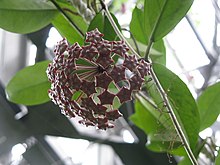Hoya purpureofusca
| Hoya purpureofusca | ||||||||||||
|---|---|---|---|---|---|---|---|---|---|---|---|---|

Inflorescence with flowers, inflorescence with buds |
||||||||||||
| Systematics | ||||||||||||
|
||||||||||||
| Scientific name | ||||||||||||
| Hoya purpureofusca | ||||||||||||
| Hook. |
Hoya purpureofusca is a plant of the genus of wax flowers ( Hoya ) of the subfamily of asclepiadoideae (Asclepiadoideae).
features
Hoya purpureofusca is a climbing plant with only a few twisting shoots. The shoots have a diameter of up to 4 mm and are glabrous. The thick, succulent leaves are stalked, the very thick, brownish petioles are up to 15 mm long. The leaf blades are dark green, egg-shaped, 10 to 16 cm long and 7.5 to 10 cm wide. The apex is pointed to long, the base of the leaf is round. The leaf veins are palm-shaped, with 3 to 5 leaf veins.
The hemispherical inflorescence contains 15 to 38 flowers, it starts in the leaf axils. The inflorescence stalk is 8 to 12.5 cm long. The flower stalks are thin and 2.9 to 3.3 cm long. The sepals are subpulate. The corolla has a diameter of 1.5 cm. It is dark pink to dark purple in color, bald or downy-haired to wire-haired on the inside. The petal lobes are bent back, the edges of the lobes are bent inwards. The secondary crown is flat and 0.8 cm in diameter. The dark pink to purple brown staminal corolla lobes are ovate, pointed and keeled on top. They are sunk in the middle and convex on the underside. The middle of the secondary crown is yellowish. The flowers exude a lot of nectar and have a sweet smell of honey.
Similar Art
Hoya purpureofusca is closely related to Hoya cinnamomifolia . It is difficult to distinguish the two species from the leaves. The color of the flowers is different. Hoya pubicalyx has very similar flowers, but differs in the veins of the leaves.
Geographical distribution and habitat
The range of the species is limited to mountain regions (approx. 1000 m to 1500 m above sea level) on Java and Bali , Indonesia.
Taxonomy
The taxon was described by William Jackson Hooker in 1848 . Since Hoya cinnamomifolia is very similar in the vegetative parts and the flower structure, Robert Dale Kloppenburg evaluated Hoya purpureofusca as the variety of Hoya cinnamomifolia . Most of the authors did not follow this suggestion. Plants of the World online accepts Hoya purpureofusca as a valid taxon and uses Hoya cinnamomifolia var. Purpureofusca (Hooker) Kloppenburg (2001) as a synonym.
The lectotype was established by Rahayu & Rodda (2019). It is in the herbarium at Kew Gardens in London (T. Lobb sn leg .; K000894742).
literature
- Christiane Hoffmann, Ruurd van Donkelaar, Focke Albers: Hoya. In: Focke Albers, Ulli Meve (ed.): Asclepiadaceae (silk plants). (= Sukkulenten-Lexikon. Volume 3) pp. 147-160, Ulmer, Stuttgart 2002, ISBN 3-8001-3982-0 (p. 158).
- Robert Dale Kloppenburg, Ann Wayman: The World of Hoyas - a pictorial guide. A revised version. 248 pp., Orca Publishing Company, Central Point, Oregon, 2007 ISBN 0-9630489-4-5 (pp. 222/23)
- Anders Wennström, Katarina Stenman: The Genus Hoya - Species and Cultivation. 144 p., Botanova, Umeå 2008 ISBN 978-91-633-0477-4 (p. 115)
Individual evidence
- ↑ a b c d e Sri Rahayu, Kartika Ning Tyas dan Hary Wawangningrum: Morphological variation of Hoya purpureofusca Hook.f. from Gu8nung Gede Pangrango National Park. In: Berita Biologi , Volume 18, No. 2, 2019 doi: 10.14203 / beritabiologi.v18i2.3490 P-ISSN 0126-1754, E-ISSN 2337-8751, pp. 215-223
- ↑ William Jackson Hooker: Hoya purpureo-fusca. In: Curti's Botanical Magazine , Volume 76, 1850, Plate 4520 + Text Online at Biodiversity Heritage Library
- ↑ Joya purpureofusca Hooker. Kew Sciences - Plants of the World online. Retrieved May 26, 2020. (English)
- ↑ Sri Rahayu, Michele Rodda: Hoya of Sumatra, an updated checklist, three new species, and a new subspecies. In: European Journal of Taxonomy. No. 508, 2019, pp. 1–23 ISSN 2118-9773 doi: 10.5852 / ejt.2019.508 , here p. 11.
